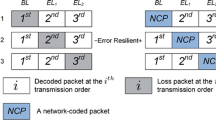Abstract
The evolved Multimedia Broadcast Multicast Service (eMBMS) using the Multicast Broadcast Single Frequency Network (MBSFN) technique was designed for having multimedia streaming services using the multicast/broadcast way over the cellular network. Since (1) the unit of resource allocation in eMBMS-MBSFN is a subframe, (2) the code rate of an eMBMS-MBSFN session is based on the lowest Modulation and Coding Scheme (MCS) among involved User Equipments (UEs) of the eMBMS-MBSFN session and (3) the resource allocation for eMBMS-MBSFN cannot be so instantly and dynamically adjusted based on the status of involved UEs, triggering eMBMS-MBSFN in the inappropriate time and allocating inappropriate resource to eMBMS, for which a framework of how to set the configuration of the allocated resource for eMBMS-MBSFN has been defined in the standard, may cause (1) the radio resources to be wasted and (2) the low streaming quality and code rate. Based on the MBMS operation on Demand (MooD) concept, this work proposed the Incremental Allocation of Radio Resource between Unicast and Multicast (IARR-UM) method to dynamically allocate radio resources to eMBMS based on the current Radio Access Network’s (RAN’s) congestion situation such that some suitable multimedia streaming services are switched to eMBMS and others still use unicast communication. To effectively use eMBMS to mitigate RAN’s congestion, the proposed IARR-UM method (1) dynamically increases/decreases the amount of radio resources allocated to eMBMS, i.e., modifying the configuration of the allocated resource for eMBMS-MBSFN using the standard’s framework, based on the situation of RAN’s congestion, (2) uses the Knapsack algorithm to select a subset of suitable multimedia streaming services to be eMBMS sessions according to the given amount of radio resources allocated to eMBMS, and then (3) design a Common Subframe Allocation (CSA) pattern that can have the lower amount of redundant radio resources allocated to eMBMS. The results of the performance evaluation shown that the proposed method can (1) provide UEs with appropriate radio resources and (2), although the throughput may be reduced in some cases, effectively reduce (increase) the UEs’ invalid packet rates (data rates), especially in the higher density of UEs’ situation.







Similar content being viewed by others
References
Capozzi, F., Piro, G., Grieco, L. A., Boggia, G., & Camarda, P. (2013). Downlink packet scheduling in LTE cellular networks: Key design issues and a survey. IEEE Communications Surveys & Tutorials, 15(2), 678–700.
Van Der Hooft, J., Petrangeli, S., Wauters, T., Huysegems, R., Alface, P. R., Bostoen, T., & De Turck, F. (2016). HTTP/2-based adaptive streaming of HEVC video over 4G/LTE networks. IEEE Communications Letters, 20(11), 2177–2180.
Cicalò, S., Changuel, N., Tralli, V., Sayadi, B., Faucheux, F., & Kerboeuf, S. (2016). Improving QoE and fairness in HTTP adaptive streaming over LTE network. IEEE Transactions on Circuits and Systems for Video Technology, 26(12), 2284–2298.
ETSI, TS(2012-11). "136 331 V9. 12.0" LTE; Evolved Universal Terrestrial Radio Access (E-UTRA); radio resources control (RRC); protocol specification.
ETSI, TS(2012-11). "136 300 V11. 3.0" LTE; Evolved Universal Terrestrial Radio Access (E-UTRA) and Evolved Universal Terrestrial Radio Access Network (E-UTRAN); overall description; stage 2.
ETSI, TR(2015-06). "26 849 V12. 1.0" Technical Specification Group Services and System Aspects; Multimedia Broadcast/Multicast Service (MBMS) improvements; MBMS operation on demand.
ETSI, TS(2016-05). "136 443 V13. 3.0" LTE; Evolved Universal Terrestrial Radio Access Network (E-UTRAN); M2 Application Protocol (M2AP).
Ghandri, A., Boujelben, Y., & Ben Jemaa, M. (2018). Dynamic MBSFN subframe allocation algorithm for bursty video traffic in LTE-Advanced network. In Proceedings of the 14th IEEE wireless communications and networking conference (WCNC) (pp. 1–6).
Lau, C. P., Alabbasi, A., & Shihada, B. (2017). An efficient live TV scheduling system for 4G LTE broadcast. IEEE Systems Journal, 11(4), 2737–2748.
Chen, J., Chiang, M., Erman, J., Li, G., Ramakrishnan, K. K., & Sinha, R. K. (2015). Fair and optimal resource allocation for LTE multicast (eMBMS): Group partitioning and dynamics. In Proceedings of the 11th IEEE conference on computer communications (INFOCOM) (pp. 1266–1274).
Ghandri, A., Boujelben, Y., & Ben Jemaa, M. (2018). A low-complexity scheduling for joint unicast and multicast transmissions in LTE-A network. In Proceedings of the 14th international wireless communications & mobile computing conference (IWCMC) (pp. 136–141).
Kaliski, R., Chou, C., Meng, H., & Wei, H. (2016). Dynamic resource allocation framework for MooD (MBMS Operation On-Demand). IEEE Transactions on Broadcasting, 62(4), 903–917.
Araniti, G., Scopelliti, P., Muntean, G., & Iera, A. (2019). A hybrid unicast-multicast network selection for video deliveries in dense heterogeneous network environments. IEEE Transactions on Broadcasting, 65(1), 83–93.
Rhee, J.-H., Holtzman, J. M., & Kim, D.-K. (2003). Scheduling of real/non-real time services: Adaptive EXP/PF algorithm. In Proceedings of the 57th IEEE semiannual vehicular technology conference (Vol. 1, pp. 462–466).
Xiantao, L., Guangyi, L., Ying, W., & Ping, Z. (2006). Downlink packet scheduling for real-time traffic in multi-user OFDMA system. In Proceedings of the 64th IEEE vehicular technology conference (pp. 1–5).
Ning, X., Ting, Z., Ying, W., & Ping, Z. (2006). A MC-GMR scheduler for shared data channel in 3GPP LTE system. In Proceedings of the 64th IEEE vehicular technology conference (pp. 1–5).
Pokhariyal, A., Kolding, T. E., & Mogensen, P. E. (2006). Performance of downlink frequency domain packet scheduling for the UTRAN long term evolution. In Proceedings of the 17th IEEE international symposium on personal, indoor and mobile radio communications (pp. 1–5).
Acknowledgements
This work was supported by the Ministry Of Science and Technology (MOST), Taiwan (R.O.C.) under the Grant Number MOST 108-2221-E-006-100-MY3.
Author information
Authors and Affiliations
Corresponding author
Ethics declarations
Conflict of interest
On behalf of all authors, the corresponding author states that there is no conflict of interest.
Additional information
Publisher's Note
Springer Nature remains neutral with regard to jurisdictional claims in published maps and institutional affiliations.
Rights and permissions
About this article
Cite this article
Huang, CM., Li, ML. The MBSFN-based eMBMS using the method of Incremental Allocation of Radio Resource between Unicast and Multicast (IARR-UM). Telecommun Syst 77, 709–730 (2021). https://doi.org/10.1007/s11235-021-00789-8
Accepted:
Published:
Issue Date:
DOI: https://doi.org/10.1007/s11235-021-00789-8




